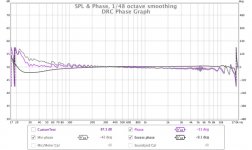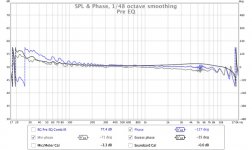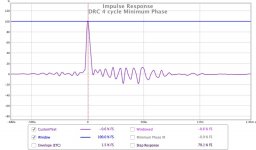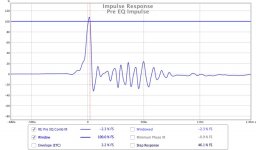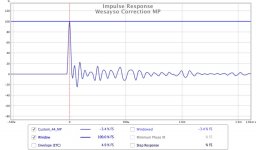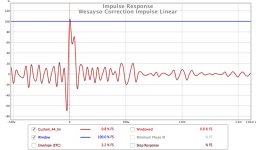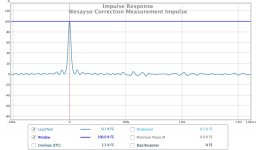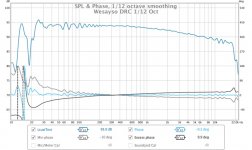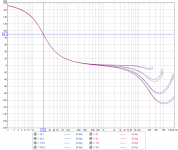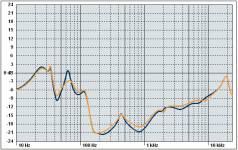As far as I know this was the outside measurement corrected with gmad's correction (min phase) from the convolution thread 🙂.
I could be wrong though..
I could be wrong though..
I get a little confused what you mean and also not sure if purple curve fluid showed is in room at listening position or it is some synthetic predictions, below is extracted minimum phase for fluid's amplitude curve isn't that what to target at listening position if actual room will allow it to be possible ? 🙂
As far as I know this was the outside measurement corrected with gmad's correction (min phase) from the convolution thread 🙂.
I could be wrong though..
Sorry if I was not clear enough in my description! Wesayso is correct none of these are in room measurements. The speakers are still not even plugged in yet 😱 I hope to have that rectified soon.
It was a test to see what DRC processing did to my "virtual ideal room measurements".
This is what I did:
Outdoor measurement convolved with EQ to mimic the predicted room gain. (An attempt to avoid excess low frequency correction like in the original rough EQ that was nearly flat to 20Hz outside)
Basic Pre EQ in REW to generally straighten things out and bring it closer to flat making DRC's job easier. Convolve that EQ into the impulse to feed to DRC.
Clear as mud? 🙂
I don't know if it just the scale of the graph the FDW or something else going on that makes it look that straight.a comment could be the purple correction would probably improve a bit in rhytm feel if phase exactly follow amplitude using "Generate minimum phase" button to show the phase target differences from that pretty straight purple phase curve, that said take your time to investigate the different corrections and comparisons.
Here is a non windowed phase graph with the DRC corrected version and the REW generated minimum phase. They are not really that different and there is no excess phase correction in the filter used. The low rolloff goes towards 180 degrees but the top end does not. I think that is partly due to the comb filtering the general trend goes down but keeps bouncing back up again.
What I find a little strange is minimum phase is above the DRC corrected phase but below the Pre EQ phase hmmm.
Pre EQ "virtual measurement"
The impulse is interesting as it has changed the pre ringing into something different but it has done a pretty good job of straightening it out. Maybe it's the double sided windowing used?
DRC corrected
Pre EQ "virtual measurement"
Attachments
In my opinion we can't separate the room from the speaker and vice versa...
Unless we live/listen in rooms with anechoic like conditions....
There are many schools of thought on speakers and rooms and I can see the logic in different arguments.
Many agree with you that the two are linked and need to be treated as one.
Others think that the speaker should be made flat anechoic and the room left alone or treated physically only.
And then any other combination of the above that you can think of.
In this I am taking your advice to try and find "my own truth" as it were 🙂
In the first instance I am not treating the room in any way, that may change later but not now. I want to see the results I can get without it.
That in itself is a big difference to your setup and may sway my preference accordingly. If you took away the room damping and ambient speakers you might prefer a different style of processing to go with that. Probably need a time machine to find out because I can't see you taking it all out to find out now!
I am interested to see what it sounds like by getting as close as I can to correcting the speaker only with generalised room gain and if this translates well in subjective listening.
Of course the room will completely destroy my carefully crafted corrected when measured but can my brain hear through the room and still get some benefit from the correction? And if so how much?
The next test after that is to measure the speaker in room via multi position average to see how that changes the outcome and compare.
With the flick of a convolution filter it should be easy enough to compare in a realistic way.
In the first instance I am not treating the room in any way, that may change later but not now. I want to see the results I can get without it.
That in itself is a big difference to your setup and may sway my preference accordingly. If you took away the room damping and ambient speakers you might prefer a different style of processing to go with that. Probably need a time machine to find out because I can't see you taking it all out to find out now!
I did listen to both... 😀
Short advice: just absorb all reflections before 6-7 ms. That's the most easy and fun way to get great results. Use correction tools to correct the speaker as best you can and keep the room in mind for tonal balance.
I did listen to both... 😀
Short advice: just absorb all reflections before 6-7 ms. That's the most easy and fun way to get great results. Use correction tools to correct the speaker as best you can and keep the room in mind for tonal balance.
I thought you did most of your DRC processing experimentation after you had installed the damping panels, quite possible I got that wrong, you would know 😀
The correction I have created to mimic anechoic conditions plus basic room gain would be different to anything made from an in room measurement which is why I am intrigued to see if it sounds good in practice.
The side walls are at 1m from the speaker, rear wall a bit more from listening position but that one is likely the only reflection below 6ms other than the front wall.
I ran the same virtual measurement through DRC with wesayso's sample template.
The longer windows have smoothed the response out even more. I made a minimum phase version to compare to one with excess phase correction.
The frequency response and phase of both came out identical even though the correction impulses are really different. Both deviate from minimum phase of the frequency response so I will need to see if there is something I can do to change that in DRC.
1/12 Oct Smoothing
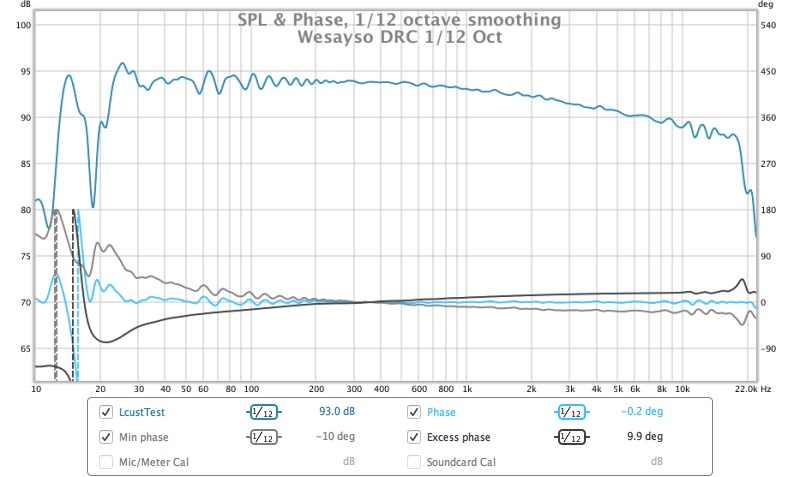
6 Cycle FDW
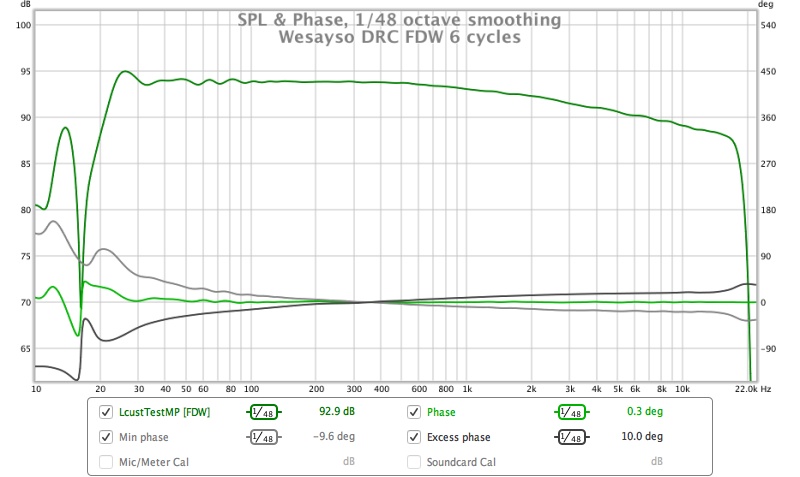
Corrected Measurement Impulse
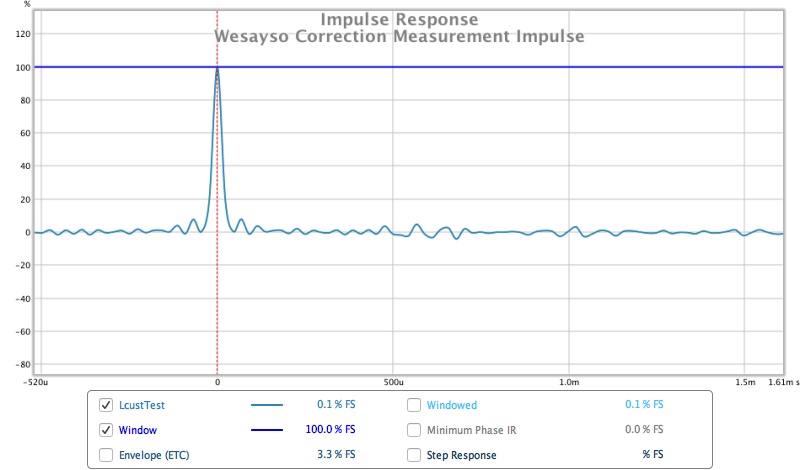
Linear Phase Correction Impulse
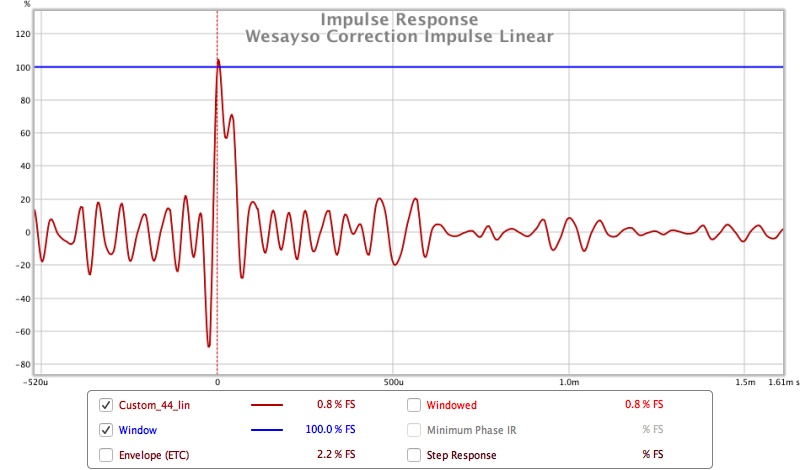
Minimum Phase Correction Impulse

The longer windows have smoothed the response out even more. I made a minimum phase version to compare to one with excess phase correction.
The frequency response and phase of both came out identical even though the correction impulses are really different. Both deviate from minimum phase of the frequency response so I will need to see if there is something I can do to change that in DRC.
1/12 Oct Smoothing
6 Cycle FDW
Corrected Measurement Impulse
Linear Phase Correction Impulse
Minimum Phase Correction Impulse
Attachments
The side walls are at 1m from the speaker, rear wall a bit more from listening position but that one is likely the only reflection below 6ms other than the front wall.
Quess sidewall reflections will be pretty close to 6 ms when speaker is 1 m from wall. 1 m in 3 ms. If one use a flexible measuretape to measure direct vs reflected one do not have to use phytagoras🙂
Some of the elements must also be very close to roof and ceiling?
First reflections lower than 15 dB compared to direct using ETC view is a good result.
The natural diffuse field because of linesource should help you.
Regarding room and speaker: In the region where a whole wavelength can not be fitted inside the room, it is very diffucult to differenciate between speaker and room.
Actually it is all the way up to the Schroder frequency
https://en.wikipedia.org/wiki/Room_acoustics
I was thinking the same 1m away from the wall equals 2m round trip which is about 6ms. Could be less depending on the angle though.Quess sidewall reflections will be pretty close to 6 ms when speaker is 1 m from wall. 1 m in 3 ms. If one use a flexible measuretape to measure direct vs reflected one do not have to use phytagoras🙂
They are but the array has quite narrow vertical directivity so the ceiling and floor reflections are less of a concern than for standard speakers.Some of the elements must also be very close to roof and ceiling?
That would be good but they may be higher than that, another thing to check when I get to in room measurements 🙂First reflections lower than 15 dB compared to direct using ETC view is a good result.
Last edited:
.....The low rolloff goes towards 180 degrees but the top end does not. I think that is partly due to the comb filtering the general trend goes down but keeps bouncing back up again.....
Sorry my extraction mislead in top end to actual situation because its not any bandwidth limited, below approximation show example of differences how phase curve looks in a 48kHz verse 192kHz domain.
Attachments
Hi fluid,
Your latest post here and one over gmad's thread is lost due to database problems that caused 4 hours activity is missing, more about that downtime is found here http://www.diyaudio.com/forums/foru...ver-downtime-database-restore-lost-posts.html.
About why would the sampling frequency have an effect on the generated minimum phase of the frequency response?
I'm not good into subject but over time have observed the differences that happen, and it looks phase at HF part always start out at zero degree point at the selected sampling frq and also we know that above half the sampling frq there will be no amplitude data to calculate phase. To show the differences created all eight possible sampling frq over in Rephase and imported to REW, they based on 20Hz-20kHz BW2 band pass so we know phase should be exactly at +90º/20Hz in low end and at -90º/20kHz in top end, as seen in top end it goes wrong and no one is exactly at -90º/20kHz point, only into Rephase phase curve in top end looks right. Could imagine because of those differences that to get best precision creating target curves and manipulating curves with math that its best to always use same sample rate into simulation as is used for measurements.
Your latest post here and one over gmad's thread is lost due to database problems that caused 4 hours activity is missing, more about that downtime is found here http://www.diyaudio.com/forums/foru...ver-downtime-database-restore-lost-posts.html.
About why would the sampling frequency have an effect on the generated minimum phase of the frequency response?
I'm not good into subject but over time have observed the differences that happen, and it looks phase at HF part always start out at zero degree point at the selected sampling frq and also we know that above half the sampling frq there will be no amplitude data to calculate phase. To show the differences created all eight possible sampling frq over in Rephase and imported to REW, they based on 20Hz-20kHz BW2 band pass so we know phase should be exactly at +90º/20Hz in low end and at -90º/20kHz in top end, as seen in top end it goes wrong and no one is exactly at -90º/20kHz point, only into Rephase phase curve in top end looks right. Could imagine because of those differences that to get best precision creating target curves and manipulating curves with math that its best to always use same sample rate into simulation as is used for measurements.
Attachments
Byrtt, thanks for the graph it does show quite a big difference and I think you are right to match sample rates in virtual simulations to those in the application with such a variation. I don't understand why it happens, but to know that is how it should look in a graph will have to do for now!
In some ways losing those posts is not an issue as I have found the reason why the phase in DRC won't follow minimum phase myself.
There appears to be a lot of excess phase in the virtual measurement at the ends of the frequency response and the overall trend in the measurement fed in is what is coming out. I hadn't realised that which is why I it made no sense!
I should be able to verify it by exporting a minimum phase version of the IR to feed into DRC.
The thing I need to work on now is trying to get the templates with phase correction to generate a minimum phase output without overdoing the phase correction to have it be a virtual straight line throughout the graph.
In some ways losing those posts is not an issue as I have found the reason why the phase in DRC won't follow minimum phase myself.
There appears to be a lot of excess phase in the virtual measurement at the ends of the frequency response and the overall trend in the measurement fed in is what is coming out. I hadn't realised that which is why I it made no sense!
I should be able to verify it by exporting a minimum phase version of the IR to feed into DRC.
The thing I need to work on now is trying to get the templates with phase correction to generate a minimum phase output without overdoing the phase correction to have it be a virtual straight line throughout the graph.
I haven't posted any new information for a while but a lot has been happening behind the scenes.
I was able to take a lot of indoor measurements 22 per side spread across my couch left to right and different distances forward. It took quite a lot of time to analyse them and see what was going on.
Initially the sound was quite disappointing compared to the mono test I had done previously. The measurements showed why. The speaker placement was all wrong and there was a huge hole centred at about 95Hz. Sweeping the generator in REW showed a complete lack of output between 90 and 105Hz. The dip was not that wide but it totally destroyed music playback. Most of the room was affected you needed to be within about a foot of the speaker before you could hear the tone. The sidewalls and rear wall to listening position were very similar reinforcing the null.
The measurements were useful to test out the averaging in REW and to see how many and which ones to concentrate on for next time. I will post some graphs when I take some new measurements.
Onto the good news. I decided to have a play with REW's room simulator. When I put the original positions in the null was well predicted so I continued to move the speakers around virtually until I got a better overall result. I moved the speakers to these positions and tested with a Parametric EQ based on the averaged measurements. Complete difference, I started listening and I have been really pleased with how these sound over a wide range of music. There are still some minor tonal issues that I need to work on (which the new measurements should make easier to pinpoint) but overall I am very happy and could live with it like this quite happily. The speakers are now 1.3m from the sidewalls, 0.5m front the front wall and the listening position is 1m from the rear wall.
The bass is now really good, vocals sound natural and I don't feel like I am missing out on the top end. For me at least the arrays are now better than my LX521 speakers on most music that I am interested in and I am hopeful that with a more refined EQ they will match or exceed them on the best recordings too.
Wesayso has given me a lot of input and the results of DRC processing look very promising so I am really looking forward to seeing what impact that has. I am confident most of the kinks in the process have been worked out now so once i can get a new set of measurements the real tweaking will begin 🙂
I was able to take a lot of indoor measurements 22 per side spread across my couch left to right and different distances forward. It took quite a lot of time to analyse them and see what was going on.
Initially the sound was quite disappointing compared to the mono test I had done previously. The measurements showed why. The speaker placement was all wrong and there was a huge hole centred at about 95Hz. Sweeping the generator in REW showed a complete lack of output between 90 and 105Hz. The dip was not that wide but it totally destroyed music playback. Most of the room was affected you needed to be within about a foot of the speaker before you could hear the tone. The sidewalls and rear wall to listening position were very similar reinforcing the null.
The measurements were useful to test out the averaging in REW and to see how many and which ones to concentrate on for next time. I will post some graphs when I take some new measurements.
Onto the good news. I decided to have a play with REW's room simulator. When I put the original positions in the null was well predicted so I continued to move the speakers around virtually until I got a better overall result. I moved the speakers to these positions and tested with a Parametric EQ based on the averaged measurements. Complete difference, I started listening and I have been really pleased with how these sound over a wide range of music. There are still some minor tonal issues that I need to work on (which the new measurements should make easier to pinpoint) but overall I am very happy and could live with it like this quite happily. The speakers are now 1.3m from the sidewalls, 0.5m front the front wall and the listening position is 1m from the rear wall.
The bass is now really good, vocals sound natural and I don't feel like I am missing out on the top end. For me at least the arrays are now better than my LX521 speakers on most music that I am interested in and I am hopeful that with a more refined EQ they will match or exceed them on the best recordings too.
Wesayso has given me a lot of input and the results of DRC processing look very promising so I am really looking forward to seeing what impact that has. I am confident most of the kinks in the process have been worked out now so once i can get a new set of measurements the real tweaking will begin 🙂
Stick with it and we will continue to grow in performance. I'm pretty sure you haven't released the complete potential yet 😀.
I'll be here to help! (and learning from this joint experience as well 😉)
I'll be here to help! (and learning from this joint experience as well 😉)
Good news, fluid.
All part of the learning experience, and as wesayso said, I'm sure you have just started to get good sound, and it should improve even more over time.
Enjoy!
All part of the learning experience, and as wesayso said, I'm sure you have just started to get good sound, and it should improve even more over time.
Enjoy!
Now I've heard the potential I am excited to see where I/We can take them 🙂Stick with it and we will continue to grow in performance.
It would be amazing if I had by using an EQ based on measurements in another position 😀pretty sure you haven't released the complete potential yet 😀.
Good to know, and I am pleased that you are getting something in return for all your efforts to help me. Shame we don't live closer or I could lend you an 8 channel Hypex amp or First One to try 😉I'll be here to help! (and learning from this joint experience as well 😉)
Thanks Perceval!Good news, fluid.
All part of the learning experience, and as wesayso said, I'm sure you have just started to get good sound, and it should improve even more over time.
Enjoy!
Hello Fluid,
In my experience, the LX521 is a pretty good standard when it comes to bass quality though higher distortion and excursion limits occurs in low frequency high SPL playback due to dipole inefficiency. If you experienced that these arrays exceed or even match the LX521 in the bass department, that really tells something. How does the array compare to the LX521 in higher spl playback ?
You are the only one who have done an outdoor measurement. Can you please share a comparison graph of outdoor vs indoor measurement. I would love to see what a typical room gain for an array looks like, which might be different compared to a conventional speaker, so difficult to simulate in software.
In my experience, the LX521 is a pretty good standard when it comes to bass quality though higher distortion and excursion limits occurs in low frequency high SPL playback due to dipole inefficiency. If you experienced that these arrays exceed or even match the LX521 in the bass department, that really tells something. How does the array compare to the LX521 in higher spl playback ?
You are the only one who have done an outdoor measurement. Can you please share a comparison graph of outdoor vs indoor measurement. I would love to see what a typical room gain for an array looks like, which might be different compared to a conventional speaker, so difficult to simulate in software.
Hi Samuel,
I find that it is the mid to high frequencies that make me turn the LX521 down, that is probably because my room has a pretty long RT60 in the mid to high frequencies. I have a few tracks that make the woofers dance due to huge low frequency content but most tracks are no issue, what are you listening to and at what level?
I don't have the arrays EQ'd properly yet but the change in position really evened out the bass a lot. I wouldn't want to make a definitive conclusion based on the limited listening I have so far and I haven't truly cranked the arrays. What I can say is I really liked the bass with LX521 and probably have it a bit too hot in the crossover settings. I don't hear anything in the arrays that make me like them any less so far.
When I take some good measurements in the new positions I will post a comparison graph of outdoor vs indoor. To do it with the measurements I have now would be misleading and end likely up going down another rabbit hole.
This is the EQ I have set now and sweeping REW's oscillator from 30Hz upwards the output is quite even apart from a few places where it dips and peaks a bit.
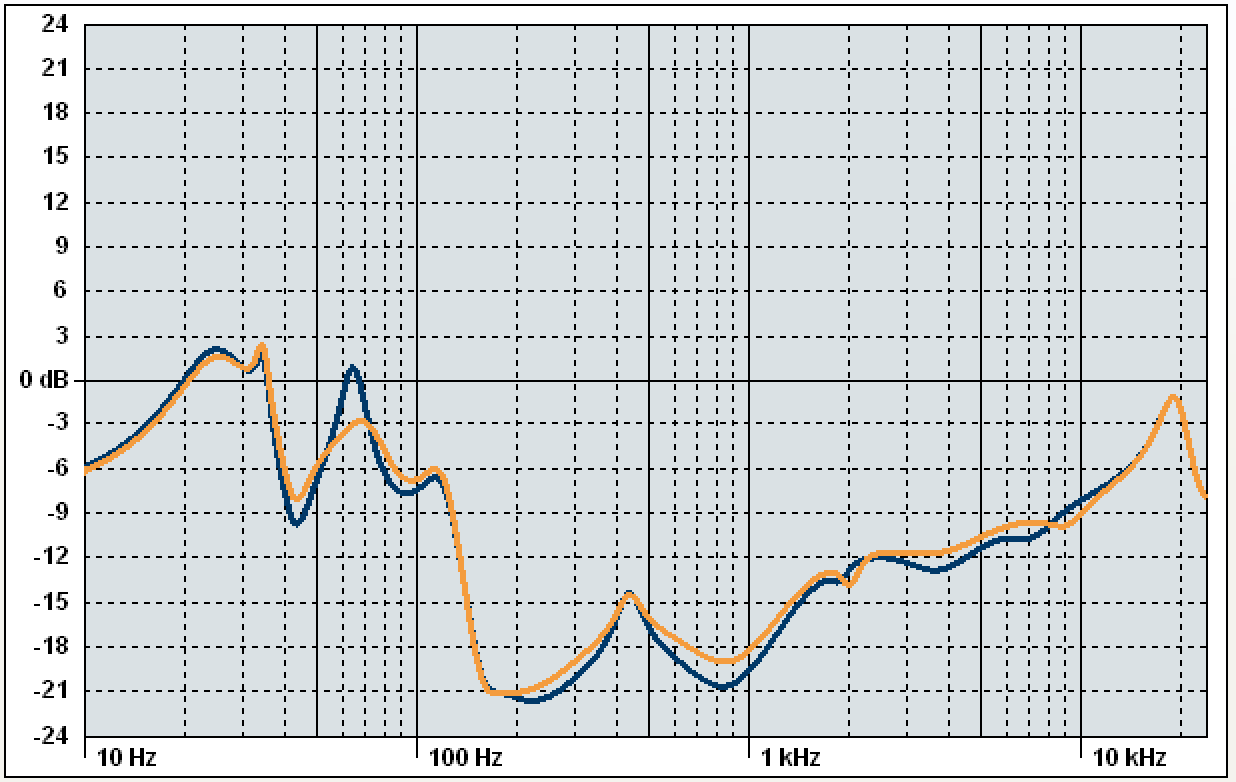
I find that it is the mid to high frequencies that make me turn the LX521 down, that is probably because my room has a pretty long RT60 in the mid to high frequencies. I have a few tracks that make the woofers dance due to huge low frequency content but most tracks are no issue, what are you listening to and at what level?
I don't have the arrays EQ'd properly yet but the change in position really evened out the bass a lot. I wouldn't want to make a definitive conclusion based on the limited listening I have so far and I haven't truly cranked the arrays. What I can say is I really liked the bass with LX521 and probably have it a bit too hot in the crossover settings. I don't hear anything in the arrays that make me like them any less so far.
When I take some good measurements in the new positions I will post a comparison graph of outdoor vs indoor. To do it with the measurements I have now would be misleading and end likely up going down another rabbit hole.
This is the EQ I have set now and sweeping REW's oscillator from 30Hz upwards the output is quite even apart from a few places where it dips and peaks a bit.
Attachments
Thanks Fluid, will wait for the graphs. Good lucking tweaking the arrays!
Your EQ portrays the very high Qts of the TC9. Around 0.5 would have been very nice.
And regarding the LX521, the hot high-mids may not be due to your room. The stock crossover settings are hot and a lot of people have attested that.
Your EQ portrays the very high Qts of the TC9. Around 0.5 would have been very nice.
And regarding the LX521, the hot high-mids may not be due to your room. The stock crossover settings are hot and a lot of people have attested that.
Thanks!Thanks Fluid, will wait for the graphs. Good lucking tweaking the arrays!
As it's electronically equalised the Q could be changed to anything. The problem is the drivers run out of excursion quickly when the frequency goes down so a Q of 0.5 would leave a lot of very low frequency boost below the f3 point. I am targeting a 24dB rolloff at 20 to 25Hz to get good extension but not risk sending through too much ULF stuff. If I went with a lower Q I would have to roll off higher to reduce the risk of over excursion. I will be trying the phase correction on the low end so in theory the transient response should be very good without the need to use a low Q alignment.Your EQ portrays the very high Qts of the TC9. Around 0.5 would have been very nice.
I was referring to the woofer crossover being a bit hot as the EQ and level interact to make it hard to know exactly the best balance. I use the HF shelving EQ as when I took it out for a flat response it was too bright. I introduced a similar correction to my Orion and that was an improvement. My Orion's are the older version before rear tweeters were added. I know the room is pretty reflective in the mid to high frequencies as seen in the RT60 measurement. It's the reason my averaged measurements change more than wesayso's compared to a single point. I suspect I would like the LX521's more if I absorbed some of the rear radiation, at some point I would like to measure them in room for comparison purposes but who knows when I will get round to that...maybe after I rewire them for 4 way active 🙂And regarding the LX521, the hot high-mids may not be due to your room. The stock crossover settings are hot and a lot of people have attested that.
- Home
- Loudspeakers
- Full Range
- Full Range TC9 Line Array CNC Cabinet
